According to the CBSE Syllabus 2023-24, this chapter has been renumbered as Chapter 6.
Introduction to Reproduction
- Reproduction is the process of giving rise to offspring.
- Reproduction is essential for the continuation of a species.
- There are two modes of reproduction:
- Sexual reproduction
- Asexual reproduction
Asexual reproduction
The type of reproduction in which only a single parent is involved is called asexual reproduction.
- There is no mixing of genetic information.
- For example, buds in Hydra
Sexual reproduction
The type of reproduction, which involves two parents to give rise to an offspring is called sexual reproduction.
- The males and females have different reproductive parts or organs.
- These organs produce the male and female gametes, which fuse together to form the offspring.
- Genetic information from both parents is inherited.
- For example, humans
To know more about Modes of Reproduction, visit here.
Fission
It is a type of asexual reproduction in which a single-celled organism divides into two.
- Division of a nucleus is followed by the division of other cell organelles in the cytoplasm and finally the cytoplasm.
- Thus, two cells are produced from one parent cell.
- Example: Amoeba.
- Amoeba reproduces by binary fission, which is dividing into two cells.
If one parent cell gives rise to many daughter cells, this type of fission is called multiple fission.
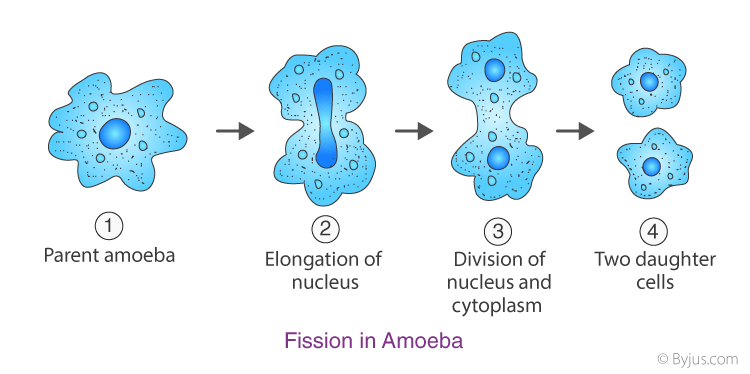
To know more about Binary Fission, visit here.
Budding
- A bud starts as an outgrowth of the parent body.
- As this bud grows, it becomes a new individual organism.
- In some organisms, the buds remain attached to the parent’s body (example: yeast)
- In some organisms, it detaches from the parent body and develops into a completely mature individual (hydra).
- This type of reproduction is called budding.
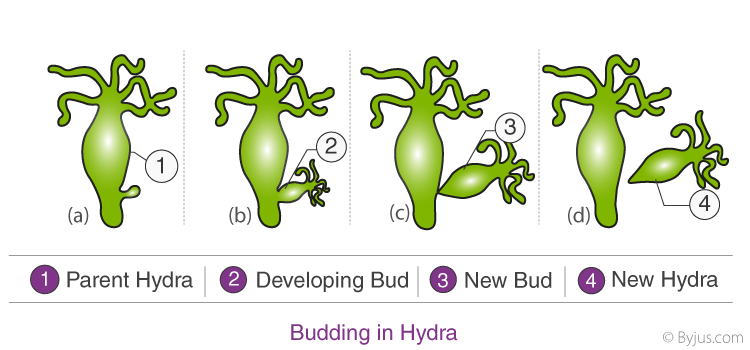
To know more about Budding, visit here.
Cell Division
- Reproduction essentially involves cell division.
- Without cell division, life will not propagate.
- The two types of reproductive processes involve two different types of cell divisions.
Cell division is the process in which a parent cell divides into two or more daughter cells.
Cell division provides more cells:
- For growth
- Regeneration
- Repair and damage control
- Gamete formation
To know more about Cell Division, visit here.
There are two types of cell division:
- Mitosis
- Meiosis
Mitosis
Mitosis is a process where a single cell divides into two identical daughter cells.
- DNA replication occurs once, followed by a single division.
- The number of chromosomes is maintained in this type of division.
- This type of division happens in asexual reproduction.
- It is also used for growth, repair and regeneration of tissues.

To know more about Mitosis, visit here.
Meiosis
This is a cell division in which a single cell divides into four haploid cells.
- DNA replication occurs once followed by two divisions.
- The number of chromosomes are halved in meiosis.
- Meiosis takes place in sex organs to produce haploid gametes.
- Thus, the gametes have only half the number of chromosomes in them.

To know more about Meiosis, visit here.
Sexual Reproduction in Humans
To know more about Male and Female Reproductive System, visit here.
Male reproductive system
- The male reproductive system consists of a pair of testes, a pair of sperm ducts and a penis.
- The testes are located outside the male body.
- Sperms are produced in testes.
- Sperms are the male gametes.

To know more about the Male Reproductive System, visit here.
Testosterone
- Testosterone is the primary male sex hormone and is produced by the testes.
- Testosterone is responsible for the development of sex organs, the production of sperm and also the development of secondary sexual characteristics.
Sperms
- Sperms are the male gametes produced by testes in humans.
- Millions of sperms are produced by the testes in a day.
- Each sperm is a single, microscopic cell having a head, a middle piece and a tail as its parts.
- The head contains a nucleus with a single set of chromosomes.
- The middle piece contains a large number of mitochondria that provide energy during active movement.
- Sperm is a motile gamete which moves through the female reproductive tract with the help of the tail.
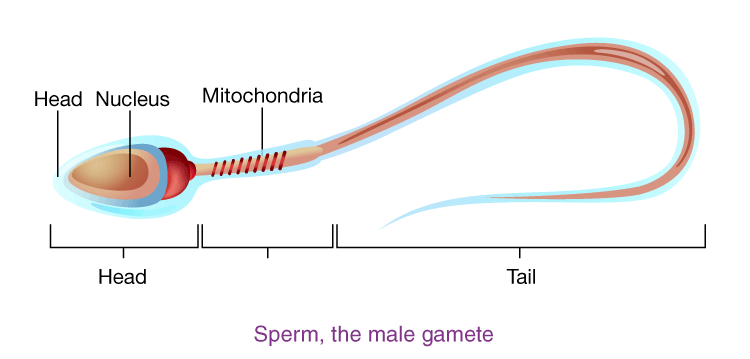
Female reproductive system
- The female reproductive system consists of a pair of ovaries, a pair of fallopian tubes (oviducts) and a single uterus.
- Ova are produced by ovaries.
- Fallopian tubes (oviducts) carry the ova from the ovaries to the uterus.
- Uterus holds the growing embryo/foetus and thus helps in holding the pregnancy.
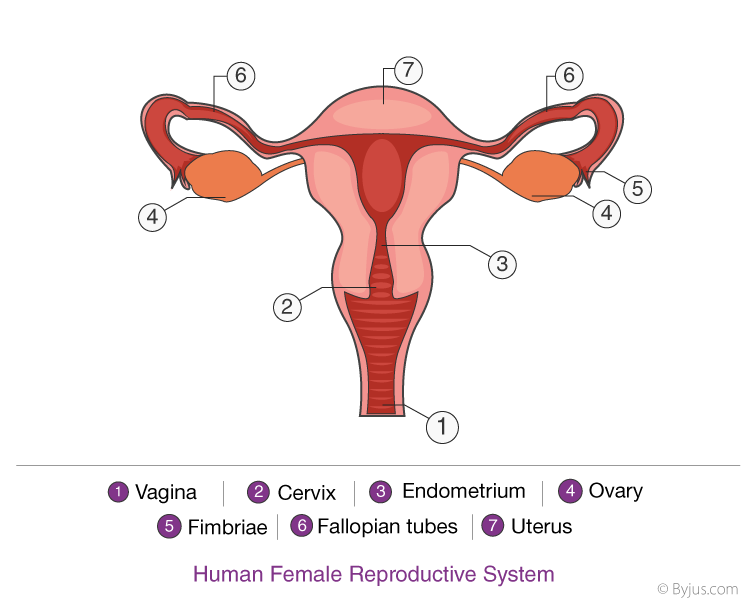
To know more about the Female Reproductive System, visit here.
Oestrogen
- Estrogen or oestrogen, is the primary female sex hormone secreted by ovaries.
- It is responsible for the development of female reproductive organs, secondary sexual characteristics, development of female gamete, i.e. Ovum and maintenance of menstrual cycle.
Ovum
- The ovary produces the female gametes known as ovum or ova (plural).
- In human beings, a single mature egg or ovum is released into the oviduct/fallopian tube by the respective side ovary every month.
- The ovum is a single cell and is much larger than the sperm.
- It is non-motile and is carried to the uterus by the oviduct.
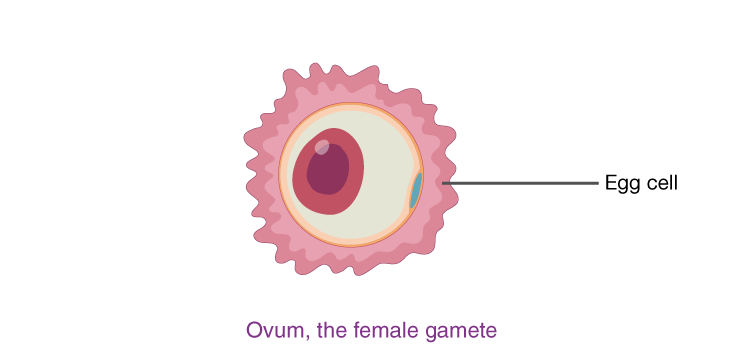
Fertilization
Fertilization is the process of fusion of the male gamete with the female gamete.
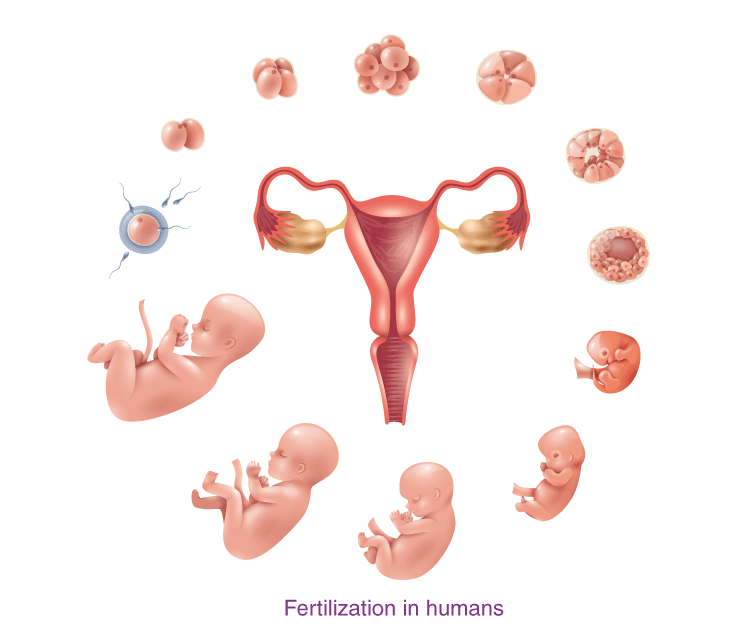
- Both the gametes containing haploid (single) sets of chromosomes fuse and thus maintain the diploid (double) number of chromosomes.
- The fertilized ovum is now called a zygote.
- In human fertilization takes place in the fallopian tube, and then the zygote is carried to the uterus.
- Inside the uterus, it undergoes repeated divisions and grows and becomes an embryo.
To know more about Fertilization, visit here.
| Also Access |
| NCERT Solutions for class 8 Science Chapter 9 |
| NCERT Exemplar for class 8 Science Chapter 9 |
For more information on Reproduction in Animals, watch the below video

Learn more about reproduction in animals and other related topics, including NCERT Class 8 Science notes, at BYJU’S.
Also Read:-
| Modes of Reproduction | Asexual Reproduction in Animals |
Frequently Asked Questions on CBSE Class 8 Science Notes Chapter 9: Reproduction in Animals
What is ‘Budding’?
A form of asexual reproduction in which a new individual develops from some generative anatomical point of the parent organism.
What is a ‘Hydra’?
Genus of invertebrate freshwater animals of the Class Hydrozoa (phylum Cnidaria) is called a ‘Hydra’.
What is an ‘Embryo’?
An unborn human or animal in the earliest stages of growth when its basic structures are being formed is called an ‘Embryo’.
Comments